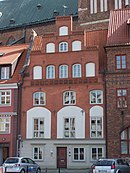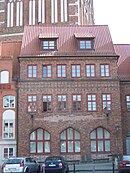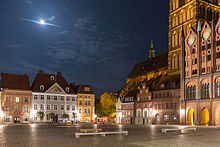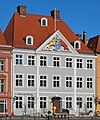Old Market (Stralsund)
The Old Market in the German Hanseatic city of Stralsund is the center of the historic old town, which has been a UNESCO World Heritage Site with the title Historic Old Towns of Stralsund and Wismar since 2002 .
The area of today's market square was settled by merchants as early as 1200, who also came to the once Slavic settlement Stralow (later: Stralsund) in the course of the German expansion to the east . The oldest Stralsund city book from 1277 names the square as a forum . After the rapid expansion of the urban area in the direction of Neustadt with the New Market there , the square is called forum antiquum , Old Market.
investment
The 60 by 80 meter square was laid out in a rectangular shape. Semlower Strasse , Külpstrasse , Mühlenstrasse and Ossenreyerstrasse lead off from it at the four corners ; opposite the town hall, Knieperstrasse also leads in front of one of the two preserved city gates, the Kniepertor .
use
The old market served as a sales point as well as a meeting place and court of law for the town on Strelasund , which was given the town charter in 1234 . The market square served as a parade area for torchlight marches and swearing-in ceremonies. During his visit to Western Pomerania in 2006, US President George W. Bush was received at the Alter Markt.
The Lambert Steinwich memorial stood on the Alter Markt from 1904 to 1938. Until the end of the tram operation, the Stralsund tram drove over the old market. Nothing has survived from the fountain that once existed here.
The square has been car-free since 2007. In the summer months it is used by the adjacent restaurants for gastronomic purposes. The annual Wallenstein Days to commemorate the defense against the siege by Wallenstein transform the market into a warehouse with stalls and tents.
From 2011 to July 2013 the old market including the western and northern Nikolaikirchhof was completely renovated; the costs for this amounted to 2.7 million euros, plus around 202,000 euros that SWS Stadtwerke Stralsund invested in the renewal of electricity, water and gas lines. The construction work was accompanied by archaeological excavations and investigations, and medieval coins and jewelry as well as a water pipe were discovered. A temporary water area with a fountain on the market was completed in summer 2012.
Sales point
Market rights were also associated with the granting of city rights. The first beginnings of Stralsund's city fortifications in the form of palisades primarily served to protect the market; only under the condition of such protection were the traders willing to take the risk that justified the transport of the goods to Stralsund. The market was under the protection of the sovereign, which was made clear by the raising of the princely flag during market days. Later the flag was replaced by one on a cross, on which the princely insignia (hat, shield, glove and sword) were attached; Violation of the market peace was punished with a fine of 60 shillings and a public ban.
Numerous booths were set up on the market square in the Middle Ages, the oldest city book mentions three shoemaker booths and several grocer booths. On the market itself there were stalls of the bakers, Haaken, butchers, dressmakers and pelters, gardeners, fishermen, Höpfner, etc. A councilor with numerous servants was in charge of compliance with the market regulations.
The market lost its function of trading center with the opening of numerous shops ( Stralsund town hall was also first used as a kophus (department store)).
Meeting place
The market square has also been used as a public meeting room since the city was founded. In the 13th century there was an etting three times a year , a solemn council meeting that ended at the beginning of the year with the election of the council. After the etting, the Bursprake , a compilation of regulations, was read out. From the years 1444 to 1693, 24 burspraken on Martini are documented in the Stralsund city archive . The reading took place first in Latin , then in Low German and finally in High German as the civil language .
The town's guests as well as its victorious conquerors were received at the market. Karsten Sarnow brought the pirates he had beaten to the market in barrels in 1391 and was received by the cheering crowd. Two years later he was executed here again to the cheering of the population. Ladewig Fischer climbed into a fish bank at the market on April 12, 1525 and called to the angry crowd from here to confess to the Reformation now and here or to the old faith, possibly saving the life of Mayor Franz Wessel during the riot . On April 12, 1628, the council members, senior men, hundred men and officers and officials of the city swore to councilor Jusquinus von Gosen to defy the threatened siege by the troops of the Catholic League under Wallenstein .
The marketplace was used by the National Socialists as it was later by the ruling SED , and in 1989 demonstrations took place here that contributed to the political change in the GDR. During his visit to Western Pomerania in the summer of 2006, US President George W. Bush was received by Chancellor Angela Merkel and Stralsund's Mayor Harald Lastovka in the Alter Markt .
Court place
The market also served as a place of execution and court from the start. The kaak served as a pillory for thieves and whores; Until the 17th century there was a wooden donkey with a sharp iron back on the corner of today's Mühlenstraße , which was then still called Hinter dem Esel , on which convicts had to sit.
The market was also the place of execution, for example for Karsten Sarnow in 1393, who was executed here, and for Raven Barnekow, who was tied to a horse here in 1453 and pulled through the streets by it. The Lübeck tree, which was first on the market, was soon moved to the town hall and later finally to the Galgenberg , the highest point in the city of Stralsund.
building
Numerous listed buildings line the old market. Only a few still have the original, medieval appearance. The city fire of 1680 destroyed some of the buildings, including the original Artushof . During the bombing raid on Stralsund on October 6, 1944 , other buildings were damaged and replaced by others during the GDR era.
South side
The Stralsund town hall with its Gothic façade facing the market stands on the south side of the market and is undoubtedly one of the most imposing buildings. The secular building dates from the 13th century. The Protestant parish church of St. Nikolai rises behind the town hall with its two church towers, the southern of which is 103 meters.
To the left of the town hall is a narrow medieval building with a baroque volute gable; the once walled-in passage was opened during the renovation after 1990 and allows the passage from the old market directly to the cemetery leading to the west portal of the Nikolaikirche. City scales were once housed in the building.
To the left of this building is house no.10 , which was built in 1930 through the redesign of the Minervahaus from 1865. From 1931 to 1945 it housed the police station and from 1945 to today parts of the city administration. From 1959 to 1995 there was also a travel agency here.
The Old Market 11 was built in the 15th century and redesigned at the beginning of the 16th century and from 1891 to 1893. The 14 terracotta tiles from the Statius von Dürens workshop were replaced by replicas. Today there is a notary's office in the three-storey, three-axis building .
The Alter Markt 12 building on the left of it dates from 1973 to 1975.
The end of the eastern row of houses is to the left of No. 12, the passage building to the Nikolaikirche, built in 1701. In the early 1980s it was torn down except for the facade. In 1997 the building was rebuilt with a glass roof.
 |
 |
 |
 |
 |

|
| Nikolaikirchportal | Old Market 12 | Old Market 11 | Old Market 10 | City scales at the town hall | Stralsund town hall |
East Side
Alter Markt 13 is the address of the three-and-a-half-story plastered building on the far right, on the corner of Semlower Strasse , which was built in 1876 in place of a Gothic gabled house.
To the left of it is the Commandantenhus , which was built as the seat of the Swedish headquarters during Stralsund's 200-year membership of the Kingdom of Sweden between 1748 and 1751. During the GDR era, the eaves house was used by the Volksmarine as a house for the army for festive occasions and as a restaurant. It was extensively renovated in 2002/2003. The Swedish coat of arms of Stralsund on the gable is a replica of the original that disappeared at the beginning of the 20th century.
A building that is essentially medieval is the neighboring house No. 15, a three-storey eaves house. The facade was redesigned in the 19th century and the house was renovated in 1992. It is used by the city administration.
The end of the row of houses is house number 16 on the corner of Fährstrasse . The three-storey house with the gable facing Fährstrasse dates from 1758 and was remodeled in the 19th century. The popular Mehlert Café was located here ; as such, the building is still known to many people from Stralsund today. An extensive renovation was completed in 2002.
North side
The north side of the Alter Markt is characterized by No. 3, a prefabricated building from GDR times , the foundation stone of which was laid on November 23, 1983 after the dilapidated building of the Goldener Löwe Hotel was blown up on July 22, 1982 . The hotel was built in the 18th century. The renovation of the building was completed in April 2003.
To the left of this is the trade union building at Alter Markt 4. The building was built in 1929/1930 according to a design by Adolf Thesmacher for the Pommern Provincial Bank in the New Objectivity style as a four-storey, brick-faced house with an outside staircase. Before that, the Stralsund City Theater, built in 1833/1834, was located here .
The Knieperstrasse leading away from the market leads directly to the Kniepertor . At the corner of Alter Markt and Knieperstrasse (with address 20 Knieperstrasse) there is a building raised by one floor in 1866, the facade of which was redesigned in the neo-renaissance style during the renovation . The house was extensively renovated after 1990.
No. 5 is the Wulflamhaus opposite the town hall , a gabled house built before 1358 which belonged to the influential Wulflam family, who provided two mayors of Stralsund with Bertram Wulflam and his son Wulfhard Wulflam .
The building to the left of the Wulflamhaus was built in 1357. The property at Alter Markt 6 belonged to the Wulflam brothers from 1334. Around 1650 the house was redesigned in baroque style and rebuilt several times in the 19th and 20th centuries. In 1997/1998 a comprehensive renovation took place; since then the building has housed the council pharmacy.
The end of the row of buildings facing Mühlenstraße is the Alter Markt 7 building, a 19th century building that was initially used as a hotel and later as a secondary school for girls. Rudolf Baier taught here, among others . The house stood empty for years and fell into disrepair. During the renovation in 2002/2003, only the facade could be saved.
West side
The west side of the market is made up of only two houses.
Alter Markt 8 was built in 1911 in place of the Swedish main guard house as a three-storey plastered building with a mansard roof , based on designs by Albert Viernow . In memory of the former Artushof Stralsund , the house was called Artushof again.
House no. 9 was built in 1967 on the place of a building that was destroyed in the bombing raid on Stralsund on October 6, 1944 . Today it houses the tourist information office for the Hanseatic city of Stralsund.
Monument protection
Under monument protection building Alter Markt are various reasons 3 (Golden Lion), 4 (Gewerkschaftshaus), 5 (Wulflamhaus), 6 (Ratsapotheke), 8 (Artus Court), 9 (tourist office), City Hall, Alter Markt 10 (ex Minerva House ), 11, the show portal to the Nikolaikirche, Alter Markt 13, 14 (Commandantenhus) 15 and 16.
Some of the buildings are part of Schwedenstrasse . In addition, the Old Market is a focal point of the UNESCO World Heritage Site Historic Old Towns Stralsund and Wismar.
literature
- Ernst Uhsemann : Forays through the old Stralsund , Publishing House of the Royal Government Printing House, Stralsund 1925
- Maike Bruhns: Ellert & Richter art travel guide Stralsund, Rügen and Hiddensee 1992
- Friederike Thomas, Dietmar Volksdorf: The old town island Stralsund - Illustrated list of monuments. The architectural monuments of the old town in text and images. Edited by the building authority of the Hanseatic city of Stralsund. Self-published, Stralsund 1999, DNB 987697757 .
- Jörg Matuschat: Stralsund history from A to Z , Stralsund 2004
Individual evidence
- ^ Ostsee-Zeitung Stralsund, June 28, 2013
- ^ Ernst Uhsemann : Forays through the old Stralsund , Verlag der Königlichen Regierungs-Buchdruckerei, Stralsund 1925, p. 64
- ^ Ernst Uhsemann: Forays through the old Stralsund , Verlag der Königlichen Regierungs-Buchdruckerei, Stralsund 1925, p. 67
Web links
Coordinates: 54 ° 18 ′ 57.5 ″ N , 13 ° 5 ′ 25.9 ″ E





















